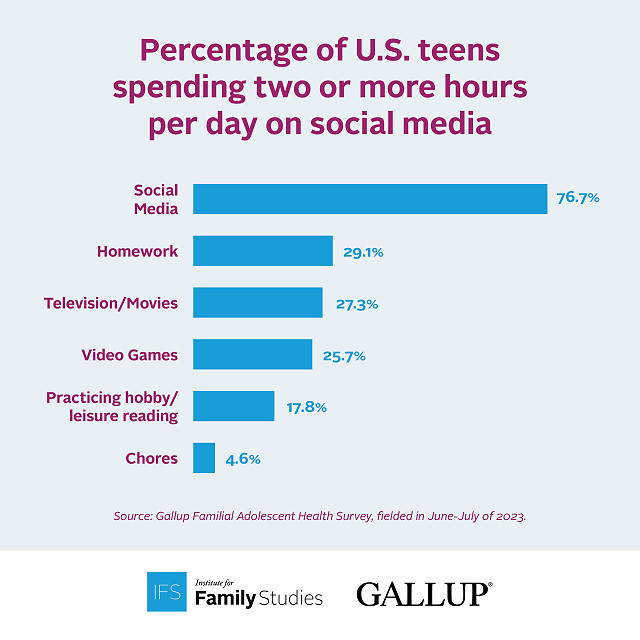How Parenting and Self-control Mediate the Link Between Social Media Use and Youth Mental Health (original) (raw)
The mental health of U.S. teenagers has declined over the past 10 to 15 years. Symptoms of mental illness have increased, as suicide rates have doubled for girls and increased by 50% for boys over the period of 1999 to 2022. Data from a continuous large-scale CDC survey of high school students and other evidence shows that depressive symptoms were not increasing until sometime around 2012 or 2013, but they have since risen rapidly.
Many scholars have carefully examined the role of smartphone use and social media apps in potentially explaining this disturbing trend. The timing of their rollout to the masses seems to largely coincide with the rise in mental health problems, and there are sound theoretical and empirical reasons for believing that smartphone and social media use are habit forming, with some addictive properties partly driven by the marketing techniques perfected by tech companies to reward and entice engagement.
New Gallup survey data, released today in a new research brief from Gallup and the Institute for Family Studies, show that U.S. teenagers spend an average of 4.8 hours per day using social media—far more time than they spend watching television, doing homework, perusing hobbies, and playing video games. Only 10.5% of teenagers spend one hour or less on social media. Nearly 30% spend upwards of six hours. Entertainment, communication, and the relief of boredom are among the most common motivations given for this use. YouTube and TikTok, two of 7 platforms examined in this report, account for most of teens’ time on social media, and their use is highest among those motivated by boredom.

To assess whether this use is associated with mental health problems, I constructed an index based on parent-reported and teen-reported measures of mental health and well-being. Consistent with most of the scholarly literature (including a recent meta-analysis), time spent on social media predicts significantly lower mental health and higher discomfort with one’s body in simple models adjusting only for child sex and age.1
Teens who spend more than 5 hours a day on social media were 60% more likely to express suicidal thoughts or harm themselves, 2.8 times more likely to hold a negative view of their body, and 30% more likely to report a lot of sadness the day before.In this study,these mental health problems were only associated with YouTube and TikTok. Body image problems show significant effects associated with time spent on YouTube, TikTok, Instagram, and WhatsApp, but not the other platforms studied here.

While these findings confirm the fears of social media critics, the effects are small relative to the large changes in mental health observed in recent years. Moreover, separating mere correlation from causation is extremely difficult in social science generally, including in the study of social media use. As some scholars have argued, low life satisfaction or other mental health problems may drive teenagers with the greatest mental health problems to social media use as a form of escapism. That behavior would produce the patterns described above, even if social media did not have any consistent effects on mental health.
To explore other potential relationships that could explain mental health outcomes and social media use, the Gallup survey asked detailed questions about parenting practices reported by the parent, as well as adolescent-reported ratings of their relationship with their parent and their own personality traits.
Children who exhibit greater self-control and/or live with parents who restrict screen time, supervise them, and sustain a strong relationship spend much less time on social media than those without these characteristics.For example, adolescents who exhibit high levels of conscientiousness spend, on average, about 1.2 hours less per day on social media than those scoring low on the trait. If living with a parent who agrees or strongly agrees that he or she restricts screen time, the adolescent reports 1.7 fewer hours, on average, of social media use, compared to adolescents whose parent does not restrict screen time. Youth who report a stronger and more loving relationship with their caregivers and spend less time unsupervised also use social media less frequently.
The negative effects of high social media use on mental health are no longer observed when matching youth on these personality and parental characteristics, and the negative effects on body image problems are cut in half, though they remain significant. In other words, screen time use has no association with an index of mental health problems for teens who demonstrate high levels of self-control and enjoy a strong relationship with parents who supervise them—a minority of American teens. Yet even teens with these characteristics show greater risk of body image issues if they are heavy users of social media.
These findings can guide parents, clinicians, and public health officials about the appropriate use of social media apps, and their regulation by parents, schools, and other institutions that interact with youth populations. New research on youth mental health and social media use should consider how personality traits and parenting experiences shape use and potentially bias outcome comparisons. Moreover, scholars should consider randomized trials and longitudinal studies that prioritize studying the most popular current platforms—such as YouTube and TikTok.
Download the full IFS/Gallup research brief.
Jonathan Rothwell is the principal economist at Gallup and a nonresident senior fellow at the Brookings Institution.
1. The effects are 0.09 standard deviations for mental health and 0.21 standard deviations for discomfort with one’s body. If poor mental health is defined as a standard deviation below the mean, the odds ratio for expressing poor mental health is 1.6 for adolescents spending four or more hours per day on social media. The odds ratio is 2.3 for expressing a negative body image, defined as a 3.5 or higher on our 1-5 scale.